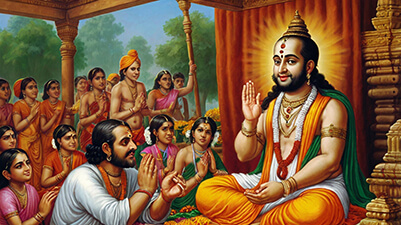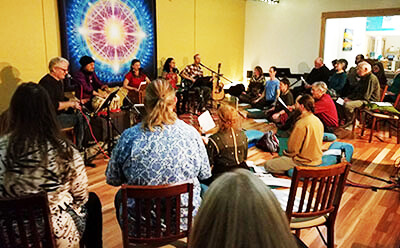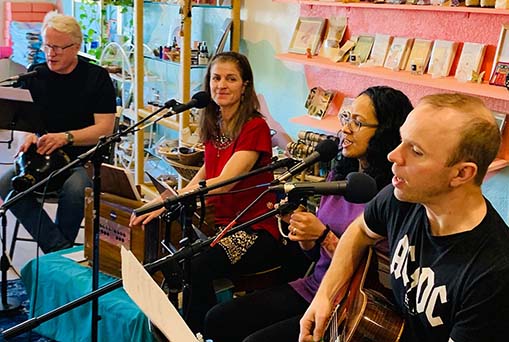Watch nearly 400 videos on the Vocal Medicine Channel!
What is Kirtan?
Kirtan (keer’ tn) is a form of devotional singing, often practiced as call and response. The leader (known as a kirtan wallah) will sing a line and participants repeat the line. The practice of kirtan originated in India and is now gaining popularity in the Western world. Kirtan is part of the Bhakti tradition. Bhakti is the yoga of devotion, a heart-centered practice usually focused on a particular aspect of God.
Roots of Kirtan Music
Although kirtan has Eastern roots, many spiritual traditions, in fact nearly all cultures worldwide, have various forms of participatory singing. A broad definition of kirtan is a spiritual gathering emphasizing group singing and transformational music.
Share this page with a friend!

Kirtan Meaning
Kirtan can be defined simply as chanting the names of God. Others view kirtan as a form of mantra meditation. Kirtan is a growing phenomenon in the West, often associated with yoga studios or meditation centers. In addition, the value of kirtan music as a form of group singing is being studied scientifically as a powerful antidote to isolation and stress in modern society.
Kirtan Definition
The word “kirtan” comes from Sanskrit and means “to tell, call, recite or praise.” Though this may include poetry and dance, as a general thing kirtan specifically refers to the practice of singing mantras. Kirtan is a gathering for the purpose of chanting or singing devotional songs. There are no particular beliefs required and you do not have to be a musician.
Other Terms for Kirtan
Chanting or kirtan is also known as mantra yoga. The word “mantra” is derived from two Sanskrit words. “Man” is from “manas” or mind. “Tra” is from “trai”, meaning to protect or free from, sometimes translated as an “instrument.” Mantras are worded formulas with distinct impacts on emotional, mental and spiritual states. Many traditional mantras are taken directly from Sanskrit scriptures. In Western kirtan, a single line may be repeated with variations in melody.
Science of Kirtan
There are many levels to the practice of kirtan, including the physical, social and spiritual. On the physical level, group singing releases feel-good chemicals like dopamine and oxytocin. The sound itself also stimulates the brain as a resonance chamber. This is believed to positive affect the pituitary gland, hypothalamus, and pineal gland.
Mantras and the Mind
Mantras are used to gain freedom from a limited state of mind. In addition, mantras can be used to revitalize the physical body as well as heal the emotions and the spirit. In kirtan music, mantras may be sung in unison or repeated in a call and response format between a leader and audience. In Vedic chanting, scriptures are recited together using only three tones.
Kirtan Benefits for Physical Health
In addition to the benefits or kirtan to the brain, the lungs and heart are positively impacted by an increased flow of oxygen. The process of steady breathing helps to calm the mind. In this way, kirtan is a form of pranayama or controlled breathing practice. Singing is a wonderful way to increase lung capacity. In a group setting, the phrasing of music synchronizes the breathing patterns of the group, ultimately synchronizing heart rate as well.
Kirtan Singing as Acupressure
Finally, the action of the tongue in singing stimulates the 84 meridians that end in soft and hard palates of the mouth. As the tongue stimulates these acupuncture points, endocrine gland secretions are shifted accordingly. In this way, the repetition of mantras is a form of internal massage or acupressure.
Positive Impact of Singing in Kirtan
On the social level, group singing has been shown to be more effective than medication or therapy for depression, anxiety and isolation. In a modern world filled with the poison of isolation, the practice of group singing is a fantastic antidote. Research by Nick Stewart of Bath University has shown that group singing (choir participation) for one year changed the outcomes of some individuals diagnosed with depression.
Kirtan Styles and Approaches
When the practice of group singing focuses on devotional or inspirational singing, those benefits may be accelerated even further. Some kirtans are specific to a particular tradition, such as the chants associated with kundalini yoga or the chants written by a particular individual or guru. Others are focused on original chants in a more Western style. There are many styles and approaches to kirtan, allowing for variety that appeals to diverse groups.
Kirtan Meaning & Social Connection
Kirtan is a platform for a profound sharing of energy, heart, and soul. A case could be made for the idea that this is the deepest possible level of intimacy. After all, the heart and soul are the deepest places in our beings, and singing is a tangible release from those places.
Synchronizing with Others through Kirtan
The process of singing vibrates every cell of each individual participating in kirtan. That vibration impacts everyone else present. The sounds merge together completely, passing through everyone present. As noted above, chanting together synchronizes breathing and heartbeat patterns.
The Bliss of Merging with Sacred Sound
Filling oneself with sacred sound creates a sense of oneness with life. This can be profoundly moving. The experience of merging with something more powerful than yourself and with the others in the group is both spiritual and tribal in nature. in this process, there is often a bliss that emerges similar to a runner’s high or the sense of being “in the zone.”

Story of the Founder of Kirtan
There are many legends about the origin of kirtan. One of these stories focuses on the modern founder of kirtan in India a sixteenth century monk named Tulsidas. Some facts about his life are known, although they are mixed with conflicting stories. In any case, the origin of kirtan is a fascinating story of survival, devotion, and rebellion.
A Baby Becomes an Orphan
A baby born in 1497AD near Varanasi, India, had a very rough start in life. At his birth, an astrologer told his father that he would bring evil to his household. Sure enough, his mother died shortly after his birth. Other reports are that his mother did not die, but agreed with her husband’s concerns and allowed the baby to be sent away.
The Baby’s Life is Saved
The baby is said to have spoken the name “Ram” as a newborn infant. Therefore, the baby was named Rambolo (meaning “I sing of Ram”). Ram is a Hindu god and incarnation of Vishnu. Knowing that the child was being rejected, a maid in the house pleaded for Rambolo’s life. She was given the baby.
The Young Child is Rejected
Rambolo’s adopted mother raised him for approximately seven years. Then she also died. Due to his adopted mother’s death, Rambolo’s foster father thought that the astrologer’s predication of a curse associated with the boy was coming true. The young boy was put out into the streets.
Baby Rambolo Becomes the Monk Tulsidas
At the age of seven, the little boy was begging on the streets to survive. Eventually as ascetic monk took pity on him and adopted him. The boy was initiated into the life of a monk and given the new name of Tulsidas. For the next fifteen years, Tulsidas happily studied the scriptures and practiced meditation.
Tulsidas Becomes a Householder
Eventually Tulsidas decided to be a householder. He met and married a wife whom he loved dearly. They had a son who unfortunately died as a toddler. His wife returned to the home of her family to recover from this loss. Tulsidas was so lonely for her that he set off to visit her. He swam across a river at night to reach her, risking his own life.
Tulsidas Returns to the Monastery
When he arrived at her family home, she chided him severely, declaring that if he was half as devoted to God as he was to her, he would reach enlightenment. Upon hearing this, Tulsidas renounced her as well as all aspects of his life as a householder. From that point forward, Tulsidas returned to the monastery and spent all of his time teaching and chanting.
A Hindu God Appears to Tulsidas
As Tulsidas taught day by day, he noticed an old leper who was always the first to arrive to hear his teachings. The leper sat off by himself. Tulsidas began to suspect that this was no ordinary leper. One day Tulsidas followed the leper into the forest and demanded that he show his real form. The Hindu god Hanuman appeared before him. Tulsidas asked Hanuman if he could also see Lord Ram, to whom he had been devoted from birth.
Tulsidas Meets Ram
Hanuman instructed Tulsidas to move to another city, which he did. One day in that city, Tulsidas was applying sandalwood paste to his students when Ram came before him. Tulsidas was so shocked that he could not proceed. Ram applied the paste to his own forehead and than to Tulsidas before disappearing.
Tulsidas Raises a Man from the Dead
The fame of Tulsidas grew. He was known to perform miracles including raising a man from the dead. Once a funeral procession was passing through the town. The widow begged Tulsidas to bring her dead husband back to life. Tulsidas gathered a group around the man and asked them to recite “Lord Ram.” The man rose from the cot on which he had been carried and returned home alive and well.
Tulsidas Rebels Against the Caste System
Around this time, Tulsidas had a dream in which the Hindu god Shiva and his consort Parvati instructed him to compose sacred poetry in the vernacular language. This would allow people of classes other than the Brahmin priests to read the poetry. This was a dangerous rebellion against the existing religious order.
Tulsidas Holds the First Kirtan
Tulsidas wrote the requested poetry and began to translate other sacred texts into the languages known by the common people. He is also reputed to have held gatherings in which he taught mantras to anyone who came. These were the first kirtans.
Tulsidas is Arrested
Tulsidas was warned that everyone would be arrested who attended his kirtans. However, nearly a thousand people are said to have come to sing with him when they heard about this threat. This was too many people to put in jail, so only Tulsidas was arrested. He was thrown in jail for his offenses.
Monkeys Aid Tulsidas
While in prison, Tulsidas began to compose a poem to Hanuman, known as the Hanuman Chalisa. The monkeys of the forest are said to have invaded the town where he was imprisoned, causing havoc in the markets and streets. Since Hanuman is the monkey-faced god, the other priests and monks believed that this was divine intervention.
Emperor Akbar Releases Tulsidas
The priests asked the emperor Akbar to release Tulsidas, which he did. Tulsidas spent the remainder of his life translating scriptures, writing spiritual poetry and composing plays about the life of Rama. These plays, or Ramalila, were written in the vernacular language so that all people could learn the stories of Rams. Eventually, Akbar and Tulsidas became friends. Tulsidas is said to have lived to be 126 years old.
Watch nearly 400 videos on the Vocal Medicine Channel!
Kirtan Music and Cultural Appropriation
Kirtan is quickly becoming a melting pot of cultures and traditions. Some kirtan leaders and participants study Hindu and Buddhist traditions extensively. Others simply love the heart-opening practice and the tremendous sense of community. Sacred group singing can be practiced with music from any tradition.
Kirtan as a Universal Spiritual Practice
Personally, I believe that the soul or spirit does not possess cultural or national identity. The soul is the inheritor of all traditions that lead back to the Source of life. I feel that utilizing the amazing gifts of multiple traditions in a respectful way honors all cultures in an expression of the highest aspirations of humankind.
Kirtan Music and Improvisation
A concept related to the benefits of group singing is referred to as flow. Improvisational music creates a feeling of flow. This is akin to being “in the groove” or being lost in the music. Kirtan music shares this concept with jazz music as well as with other genres such as gospel and blues.
Social Aspects of Kirtan Music
There is also a social aspect to flow. In kirtan, musicians and participants coordinate with each other. For example, the pace varies back and forth within a chant. Everyone has to be cognizant of the shifts that are occurring in this interplay for this to work. In addition, the same phrases may be repeated with a new melody. Studies indicate that improvised musical experiences elicit higher levels of social flow and bonding than highly structured music.
Participating in Kirtan
During kirtan music, instrumentalists may play solos for an interlude and then group chanting resumes. This creates a high level of interdependence among the musicians and the participants. This fosters the sense of being in the moment, similar to the concentration that happens during meditation and other spiritual practices.
Instruments Used in Kirtan Music
Kirtan music is often played on a harmonium. The harmonium is a small keyboard instrument with a hand-pumped bellow and two sets of internal reeds (treble and bass). The level for each is controlled by metal stops on the front of the instrument. Sound is produced when a key is pressed, allowing air to flow over the reeds.
Using a Harmonium in Kirtan
The harmonium sounds something like a cross between a small organ and a bagpipe, producing a unique eerie, longing tone. The sound is continuous, producing a constant through chords, single held notes or melodies. This is perfectly suited for both kirtan music and some Western hymns. In addition, the harmonium is an acoustic instrument, easy to play in a variety of circumstances.
Harmonium as a Drone Instrument
The drone of the harmonium establishes the foundation for kirtan music. Some musicians view this as masculine energy. This contrasts with the feminine energy playing melody. The two sounds can move back and forth between dissonance and harmony. This generates a unique sound and interplay.
Other Kirtan Instruments
Kirtan music lends itself to accompaniment by other instruments such as kartals (small hand-held cymbols) or tabla. The tabla is an Indian drum that takes many years of practice to learn. Playing tabla is quite complex rhythmically and tonally.
Modern Kirtan Instruments
All kinds of other acoustic and electronic instruments are now being used as part of kirtan music: guitars, cellos, violins, flutes and more. Kirtan music can also be led acapella, simply with voice and without any instruments at all.
The Role of Harmony in Kirtan Music
Another topic related to the format of kirtan music is whether everyone should sing the same melody or include counterparts or harmony. Harmony is the use of multiple tones within a structure such as a chord played or sung simultaneously. Barbershop and choral singing are both examples of vocal harmony.
Using Harmony in Kirtan
Harmony is typically a Western approach to group singing. Harmony is also possible with Hindu, Buddhist, Sikh or other chants. On the positive side, having some participants or musicians singing in harmony creates a fuller sound with its own beauty.
Singing in Unison in Kirtan
However, some proponents of kirtan music and chanting advocate singing only in unison. Paramhansa Yogananda, one of the early Indian teachers to introduce chanting to Americans, explains this perspective in his book Autobiography of a Yogi.
Yogananda’s Approach to Harmony
Yogananada states that melody rather than harmony is emphasized in Indian music. Yoganada believed that singing in unison supported an emphasis on the individual’s communion with God. He was concerned that harmonizing with other voices would create a more horizontal focus.
A Western Approach to Kirtan Music
In the Western world, we are accustomed to harmony. This is true in religious or spiritual music as well as popular culture. For example, Gregorian chants are typically sung with several parts. This can create a sense of being transported through the music. Bottom line: both approaches are valuable. Either can be used for kirtan music.
Kirtan Music and Spiritual Protection
Spiritual practices including kirtan music are designed for self-transformation. Most traditions recognize that we have an inherent resistance to change. Even positive change can be disruptive in our lives. There may be forces or energies within or without that would interfere with progress towards greater harmony and well-being at any level.
Kirtan as a Spiritual Practice
For this reason, a discussion of any spiritual practice would be incomplete without mention of the principle of spiritual protection. The concept of spiritual protection afforded by guides, angels, deities, devas or other benevolent beings is a key tenet in nearly every religious tradition.
Protective Hindu Goddesses
In the Hindu tradition, the goddesses Kali and Durga are known as fierce warriors. Both are depicted with many arms and many weapons to protect those on a spiritual path. Based on your own traditions and beliefs, you may want to surround yourself with light or with some type of guardian spirit as part of your practice of mantras, chanting and kirtan music.
Kirtan Music and Community
One of the great joys of kirtan music is the sense of community. This is a shared practice with deep roots in our psychological and biological wiring. Singing together in kirtan can create positive relationships with others. Deep connections and friendships can be formed through this practice.
Kirtan as an Evolving Practice
The practice of kirtan music is also grounding. However, music cannot be held the way that a child or a treasured object can be held. Every chant is different, every time. You are in the present. You are in the moment, sharing the joy of sacred music. This can take place in varying formats and circumstances. Kirtan music is both an ancient art and an evolving practice.
The Music of India
In India, music is a divine art. Brahma, Vishnu and Shiva-the Hindu trinity-were the first musicians. Brahma (the Creator or Father) plays the cymbals to keep the time for the process of creation. Vishnu (the Preserver or Son) plays the drum or mrindanga.
Music and the Gods
Krisha is an incarnation of Vishnu who plays a song on the flute that calls wandering souls to their true Home. Shiva (the Destroyer or Holy Spirit) is the third person of the trinity known as the Cosmic Dancer. In addition, Saraswati, the goddess of wisdom, performs on the vina, the mother of all stringed instruments.
Musical Science in India
Although you do not have to know any of the details of Indian music to benefit from mantra yoga, a brief overview shows the intricacy of this ancient science. The Sama Veda is the world’s earliest known collection of writings on musical science. This Indian text fixes the traditional melodic scales and six basic ragas, from which an additional 126 derivative ragas are created.
Patterns of Ragas
A raga is a mode or pattern that includes a scale with a given set of notes as well as characteristic melodies. Each of the six basic ragas corresponds with a certain hour of the day, season of the year and a presiding deity. Each raga has a minimum of five notes:
Vadi (King): the leading note
Sama Vadi (Prime Minister): the secondary note
Anuvadi (Attendants): two helping notes
Vivadi (Enemy): a dissonant note
Role of Nature in Indian Music
The desire to depict nature in music is embedded in various cultural traditions around the world. In traditional Indian culture, nature is viewed as an objectification of the primal sound or vibratory word OM or AUM. Thus, man can attain control over all manifestations of nature using mantras.
Miracle of the Raga
For example, Miyan Tan Sen, a 16th century court musician for Akbar the Great, was commanded to sing a night raga while the sun was overhead. Tan Sen intoned a mantra which instantly enveloped the palace precincts in darkness.
Eastern Versus Western Music
The octaves in Indian music are divided into 22 srutis or demi semitones. These are microtonal intervals that permit fine shades of musical expression unattainable in a western chromatic scale of 12 semitones. Western music has three basic scales: major, harmonic minor, melodic minor. Indian music has 72 scales (thetas). Indian musicians do not read set notes but improvise constantly on a set theme.
Eastern Music Characteristics
Indian music is mostly confined to the three octaves most comfortable for the human voice. Melody (succession of notes) is emphasized over harmony (simultaneous notes). Harmony, a Western trait, emphasizes cooperation with other musicians or singers. Indian music is traditionally aimed at spiritual awakening and is a subjective and individualistic art. The Sanskrit word for musician is bhagavathar or “he who sings the praises of God”.
Key Signatures and Time Signatures
There are seven common time signatures in the West. In the East, there are 120 time signatures. Time signatures are based on human rhythms such as walking and breathing. An example of this is the triple time involved in respiration when sleeping. During sleep,. The inhalation is typically twice the length of the exhalation.
Frequently Asked Questions About Kirtan
Below are some commonly asked question about kirtan music and the meaning of kirtan. Please feel free to use our Contact form if you have additional questions.
1. Is Kirtan Music a Religion or Cult?
Although the word “kirtan” is from the Hindu tradition, sacred singing as a participatory spiritual practice is common to most religious traditions. Strictly speaking, kirtan music is not part of any specific religion or spiritual lineage. However, a particular leader or group may have a guru or shared tradition.
For some, the definition of “kirtan” is expanded to any type of group singing with a sacred focus. For example, there are kirtan leaders from the Jewish tradition who sing in Hebrew. A “kirtan” event might also include Christian hymns or Shamanic singing around a fire. There are also Celtic kirtan leaders and those who blend Eastern and Western songs and mantras.
2. What Type of Music is Kirtan?
Kirtan music is quite diverse. Some forms are meditative. Other kirtan music events are more like a dance party accompanied by mostly Eastern music.When I hold sacred music events, Isometimes combine Hindu, Buddhist and Christian themes. There are others who are doing something similar.
3. Where is Kirtan Held?
Kirtan may be held in a yoga studio, in a private living room, at a music festival, or out in nature. There are workshops and holistic retreats held all over the world that include mantras and kirtan. Kirtan music is not centralized in one place or within one organization.
4. Do I Have to be a Musician?
How well you sing or whether you are a trained singer is not a pertinent issue in kirtan music. No prior musical experience is required. In fact, kirtan music is ideal if you are self-conscious about singing. Your voice will blend with everyone around you.
In addition, science has shown that group singing changes the chemistry of the brain and body. These changes happen irrespective of skill level. Clearly you do not have to have professional experience as a singer or musician to reap the benefits of chanting and kirtan music.
5. What Does a Kirtan Leader Do?
Although there are variations, kirtan music generally works like this: the kirtan leader begins a chant. The leader also determines the length and pace of the chant. A single chant or mantra can vary from a few minutes to an extended period of time. If there are multiple musicians, a drummer may also be given the responsibility for the pace of the chant.
The leader in kirtan music has the role of keeping in touch with the level of engagement among participants. A typical pattern in kirtan music is for a chant to start slowly, speed up with the repetition of a line or verse, and then slow down again at the conclusion. Alternately, the pace of the chant may remain stable but the volume of the kirtan music may become softer to indicate the end of the chant.
6. Is Kirtan Music Always Call and Response?
Chanting has been practiced as a call and response format in many spiritual traditions. This is sometimes hierarchical: a priest or guru chants a line and the congregation or devotees respond. A “wallah” is a Sanskrit term for someone who performs an action. A kirtan wallah is someone who performs or leads kirtan music. This is usually a reference to someone leading in a traditional call and response format.
The traditional style is not always the case for kirtan music in the Western world, which can be done either as call and response or in a sing-along style. In either case, lines are generally repeated twice. This makes kirtan music easy to learn.
7. What are Bhajans and Mantras?
Bhajans are devotional songs or chants usually based on longer forms of Sanskrit poetry. The word “bhajan” means “singing to glorify God.” Bhajans are typically lyrical and descriptive, relaying various stories or aspects of a divine being. Bhajans are often lively and danceable.
Mantras tend to be shorter and may not address a particular deity or aspect of the divine. Mantras are often less melodic than bhajans. A bhajan may have a complex melody with repeated choruses. Mantras are often one or two lines repeated with only a few notes.
8. What is Kirtan Kriya?
Kirtan kriya is a specific meditation technique in Kundalini yoga. This technique involves combining finger movements with specific mantras. This practice has been studied with positive impacts on Alzheimer’s patients. Utilizing finger movements with the syllables of a mantra stimulates the blood flow to the motor-sensory areas of the brain. Clinical research has shown that 12 minutes a day of Kirtan Kriya can improve cognition and memory. You can learn more at Alzheimer’s Prevention.
9. What is Kirtan Sohila?
Kirtan Sohila is a specific prayer or set of prayers sung in the evening in the Sikh tradition. The name means “Song of Praise.” One or more of these hymns are also used at funerals. The collection of hymns includes a song by Guru Nanak, one by Gurua Ram Das and on by Guru Arjan.
The word Sohila is derived from the Punjabi language and means ” the time for sleep.” The Sohila is set to a musical form called a raga. The words translate as a poem of praise. A sample of the lines are as follows, “Yes, sing praises of the Lord, the fearless One of all. I would give my life for that song, which imparts the peace eternal.”
Author Kathleen Karlsen
Kathleen Karlsen is a musician, artist, writer and speaker. She is the author of two books (Flower Symbols and Vocal Medicine) and over 200 articles. Kathleen, her husband Andrew, and their five children live in Bozeman, Montana. More about Kathleen Karlsen.
WHAT IS KIRTAN? ARTICLE SUMMARY
This article explains “what is kirtan” and covers covers a wide array of topics: the meaning of kirtan music, how kirtan music affects the brain, what instruments are used in kirtan music, how Sanskrit relates to kirtan music, how kirtan music affects the brain, how kirtan music works, the history of modern kirtan and Tulsidas the founder in India. Includes videos and examples of kirtan music.
Click for all content on our Site Map
Share this page with a friend!
![]() Vocal Medicine Music on Spotify!
Vocal Medicine Music on Spotify!







